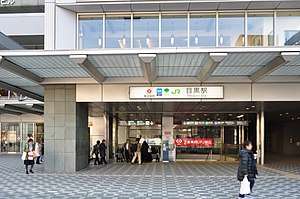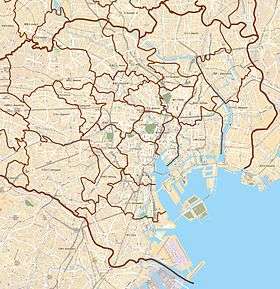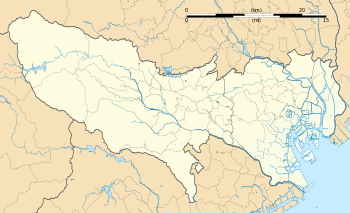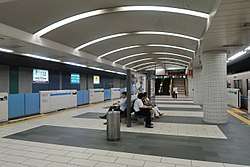Meguro Station
JY22 N01 I01 MG01 Meguro Station 目黒駅 | |
|---|---|
 The main entrance in January 2018 | |
| Location |
Shinagawa, Tokyo Japan |
| Coordinates | 35°38′02″N 139°42′58″E / 35.633983°N 139.71600°ECoordinates: 35°38′02″N 139°42′58″E / 35.633983°N 139.71600°E |
| Operated by | |
| Line(s) | |
| Platforms | 2 island platforms |
| Tracks | 4 |
| Other information | |
| Station code | MG01, I-01, N-01 |
| History | |
| Opened | 16 March 1885 |
| Location | |
 Meguro Station Location within Special wards of Tokyo  Meguro Station Meguro Station (Tokyo)  Meguro Station Meguro Station (Japan) | |

Meguro Station (目黒駅 Meguro-eki) is a railway station in Tokyo's Shinagawa ward close to the boundary with Meguro ward. The station is just south of Meguro Dori (Meguro Street).
Lines
Meguro Station is served by the following lines:
- East Japan Railway Company (JR East) Yamanote Line
- Tokyo Metro Namboku Line - through service with Tokyu Meguro Line
- Toei Mita Line - through service with Tokyu Meguro Line
- Tokyu Meguro Line - through service with Tokyo Metro Namboku Line and Toei Mita Line
Station layout
The JR East part of the station consists of one island platform serving two tracks. It also has a "Midori no Madoguchi" staffed ticket office and a View Plaza travel agency. The combined Tokyu, Tokyo Metro, and Toei part of the station consists of an island platform located on the 4th basement ("4BF") level.
JR East platforms
| 1 | JY Yamanote Line | for Shinagawa and Tokyo |
| 2 | JY Yamanote Line | for Shibuya, Shinjuku, and Ikebukuro |
Tokyu/Toei/Tokyo Metro platforms
| 1 | MG Tokyu Meguro Line | for Musashi-Kosugi and Hiyoshi |
| 2 | I Toei Mita Line | for Otemachi, Suidobashi, Nishi-Takashimadaira |
| N Tokyo Metro Namboku Line | for Iidabashi, Akabane-Iwabuchi Saitama Rapid Railway Line for Urawa-Misono |
Adjacent stations
| « | Service | » | ||
|---|---|---|---|---|
| Yamanote Line JY22 | ||||
| Gotanda JY23 | - | Ebisu EBSJY21 | ||
| Tokyu Meguro Line MG01 | ||||
| Tokyo Metro Namboku Line N01 | ||||
| Toei Mita Line I01 | ||||
| Musashi-Koyama MG03 | Express | Shirokanedai N02 I02 | ||
| Fudōmae MG02 | Local | Shirokanedai N02 I02 | ||
History
The JR East station (originally Nippon Railway station) opened on 16 March 1885.[1] The Namboku Line and Mita Line subway station opened on 26 September 2000.[2]
Half-height platform edge doors were installed on the two Yamanote Line platforms from 28 August 2010.[3]
Passenger statistics
In fiscal 2013, the JR East station was used by an average of 106,538 passengers daily (boarding passengers only), making it the 31st-busiest JR East station.[4] Over the same fiscal year, the Tokyu station was used by an average of 248,074 passengers daily, making it the busiest station on the Meguro Line.[5] In fiscal 2013, the Toei station was used by an average of 42,647 passengers daily (boarding passengers only).[6] In fiscal 2013, the Tokyo Metro station was used by an average of 102,998 passengers daily. Note that the statistics consider passengers who travel through Meguro station on a through service as users of the station, even if they did not disembark at the station.[7]
The daily passenger figures for JR East, Tokyu and Tokyo Metro in previous years are as shown below.
| Fiscal year | JR East | Tokyu | Tokyo Metro |
|---|---|---|---|
| 1999 | 110,348[8] | ||
| 2000 | 106,820[9] | ||
| 2005 | 98,344[10] | 195,425[11] | |
| 2010 | 102,310[12] | 235,597[13] | |
| 2011 | 101,998[14] | 236,572[15] | 94,530[16] |
| 2012 | 103,033[17] | 241,718[18] | 98,495[19] |
| 2013 | 106,538[4] | 248,074[5] | 102,998[7] |
- Note that JR East figures are for boarding passengers only.
See also
References
- ↑ JR East Meguro Station information Retrieved 4 March 2010. (in Japanese)
- ↑ Terada, Hirokazu (July 2002). データブック日本の私鉄 [Databook: Japan's Private Railways]. Japan: Neko Publishing. ISBN 4-87366-874-3.
- ↑ JR East press release: "山手線恵比寿駅、目黒駅のホームドア使用開始日について" (Introduction of platform doors at Yamanote Line Ebisu and Meguro Stations) (4 March 2010). Retrieved 4 March 2010. (in Japanese)
- 1 2 各駅の乗車人員 (2013年度) [Station passenger figures (Fiscal 2013)] (in Japanese). Japan: East Japan Railway Company. Archived from the original on 6 May 2001. Retrieved 7 September 2014.
- 1 2 2013年度乗降人員 [2013 Station passenger figures] (in Japanese). Japan: Tokyū Corporation. 4 June 2014. Retrieved 7 September 2014.
- ↑ 各駅乗降人員一覧 [Station usage figures] (in Japanese). Tokyo Metropolitan Bureau of Transportation. Retrieved 7 September 2014.
- 1 2 各駅の乗降人員ランキング [Station usage ranking] (in Japanese). Tokyo Metro. Retrieved 7 September 2014.
- ↑ 各駅の乗車人員 (1999年度) [Station passenger figures (Fiscal 1999)] (in Japanese). Japan: East Japan Railway Company. Retrieved 7 September 2014.
- ↑ 各駅の乗車人員 (2000年度) [Station passenger figures (Fiscal 2000)] (in Japanese). Japan: East Japan Railway Company. Archived from the original on 9 October 2014. Retrieved 7 September 2014.
- ↑ 各駅の乗車人員 (2005年度) [Station passenger figures (Fiscal 2005)] (in Japanese). Japan: East Japan Railway Company. Archived from the original on 9 October 2014. Retrieved 7 September 2014.
- ↑ 2005年度乗降人員 [2005 Station passenger figures] (in Japanese). Japan: Tokyū Corporation. 19 May 2006. Retrieved 7 September 2014.
- ↑ 各駅の乗車人員 (2010年度) [Station passenger figures (Fiscal 2010)] (in Japanese). Japan: East Japan Railway Company. Archived from the original on 6 October 2014. Retrieved 7 September 2014.
- ↑ 2010年度乗降人員 [2010 Station passenger figures] (in Japanese). Japan: Tokyū Corporation. 19 May 2011. Retrieved 7 September 2014.
- ↑ 各駅の乗車人員 (2011年度) [Station passenger figures (Fiscal 2011)] (in Japanese). Japan: East Japan Railway Company. Archived from the original on 8 October 2014. Retrieved 7 September 2014.
- ↑ 2011年度乗降人員 [2011 Station passenger figures] (in Japanese). Japan: Tokyū Corporation. 15 May 2012. Retrieved 7 September 2014.
- ↑ 駅別乗降人員順位表(2011年度1日平均) [Station passenger figures (Fiscal 2011)] (in Japanese). Japan: Tokyo Metro. Retrieved 7 September 2014.
- ↑ 各駅の乗車人員 (2012年度) [Station passenger figures (Fiscal 2012)] (in Japanese). Japan: East Japan Railway Company. Archived from the original on 7 October 2014. Retrieved 7 September 2014.
- ↑ 2012年度乗降人員 [2012 Station passenger figures] (in Japanese). Japan: Tokyū Corporation. 29 May 2013. Retrieved 7 September 2014.
- ↑ 各駅の乗降人員ランキング (2012年) [Station usage ranking (2012)] (in Japanese). Tokyo Metro. Retrieved 7 September 2014.
External links
| Wikimedia Commons has media related to Meguro Station. |
- JR East Meguro Station information (in Japanese)
- Tokyu Meguro Station information (in Japanese)
- Tokyo Metro Meguro Station information (in Japanese)
- Toei Metro Meguro Station information (in Japanese)